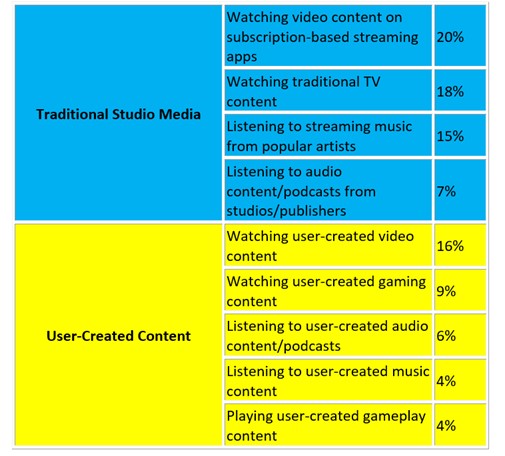CTA Study: Social Media Viewing Gaining on Traditional Studio Media
 A new study by the Consumer Technology Association has discovered that Americans now spend nearly as much time streaming videos as watching Traditional TV. Based on a survey from over 2,000 people (13 years and older), the report revealed that 39% of viewers’ weekly media time is spent watching user generated content (UGC) on social media channels such as YouTube, TikTok and Facebook. In comparison, 61% of weekly media time is spent on conventional studio media.
A new study by the Consumer Technology Association has discovered that Americans now spend nearly as much time streaming videos as watching Traditional TV. Based on a survey from over 2,000 people (13 years and older), the report revealed that 39% of viewers’ weekly media time is spent watching user generated content (UGC) on social media channels such as YouTube, TikTok and Facebook. In comparison, 61% of weekly media time is spent on conventional studio media.
Though legacy entertainment is the clear winner, UGC viewing is gaining, especially among the younger population. The study, which was initially reported on by Variety magazine, found that teens (ages 13-17) spend 56% of their media time with their eyeballs glued to social media platforms vs. those 55 and over which spend 22%. Competition is stiff, and capturing consistent viewership is getting harder and harder to achieve. Consumers have a plethora of choices at their fingertips and moreover, are used to getting content for free.
Currently, there are around 50 million content creators and only 20 million successfully monetize their content. Even then, the average monthly income according to the CTA study is only $768 a month. Further, new social media apps are being developed all the time creating more outlets and surpassing heavyweights. TikTok which was launched only six years ago in 2016, has now eclipsed viewership for YouTube according to a study from app analytics firm, App Annie who also reported that “consumers will spend 548 billion hours live streaming top social apps this year.”
Adding fuel to the fire, most conventional online social media channels are not open to adult UGC (with Twitter being the friendliest). These restrictions have made it even more difficult, setting up an unfair advantage to other sectors while the adult industry is relegated to specific adult-friendly sites only.
In the face of things, this can sound daunting to content creators in the adult space. However, the challenge of breaking through an overcrowded and sometimes hostile marketplace can be looked at in a positive light. The adult industry has long been at the forefront of developing unique ways to monetize their channels. If any sector is set to weather the storm, it’s the adult industry who has a track record of always finding an audience.
The CTA study delved into the most common ways UGC income is earned:
- “Of revenue earned by creators, 28% is from merchandise or fan experiences; 27% is from content subscriptions; 27% is from a la carte payment for content; 16% is from tips; and 2% is from other sources.”
- “Creators monetize 2-3 content categories on average, with images/photos, writing/text and video content among the most popular categories.”
- “Genres such as gaming, audio and music have fewer content creators overall but a larger proportion who are monetizing their content.”
It’s clear from the study that new and unique value-added propositions must be implemented. It’s no longer good enough to generate great or even unique content, creators must also offer perks or special experiences to viewers to compete in the marketplace. Moreover, as attention spans get smaller due to the highly snackable videos like those seen TikTok and Instagram, strategizing content by focusing on visuals vs. text can help. Specific branding that is consistent and easily recognizable is also a must.
As viewership evolves and becomes more open to UGC, those who do not embrace new ways to engage viewers will fall by the wayside. The adult industry will have to be creative to compete, especially with current restrictions in place for social media sites. However, there is a long history of adult content creators not only surviving but thriving and adapting to the changing Internet landscape.













